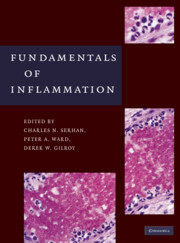Book contents
- Frontmatter
- Contents
- Contributors
- Preface
- PART I THE INFLAMMATORY RESPONSE – AN OVERVIEW
- PART II INDIVIDUAL CELL TYPES
- PART III CHEMICAL MEDIATORS
- PART IV IMMUNOPHARMACOLOGY
- PART V INFLAMMATORY DISEASES/HISTOLOGY
- 20 Lung
- 21 Neural Inflammation, Alzheimer's Disease, and Stroke
- 22 Rheumatoid Arthritis/SLE
- 23 Gastrointestinal Inflammation and Ulceration: Mediators of Induction and Resolution
- 24 Inflammatory Skin Diseases
- 25 Kidney Glomerulonephritis and Renal Ischemia
- 26 Inflammation in Cardiovascular Diseases
- PART VI ANIMAL MODELS OF INFLAMMATION
- Index
- References
23 - Gastrointestinal Inflammation and Ulceration: Mediators of Induction and Resolution
from PART V - INFLAMMATORY DISEASES/HISTOLOGY
Published online by Cambridge University Press: 05 April 2014
- Frontmatter
- Contents
- Contributors
- Preface
- PART I THE INFLAMMATORY RESPONSE – AN OVERVIEW
- PART II INDIVIDUAL CELL TYPES
- PART III CHEMICAL MEDIATORS
- PART IV IMMUNOPHARMACOLOGY
- PART V INFLAMMATORY DISEASES/HISTOLOGY
- 20 Lung
- 21 Neural Inflammation, Alzheimer's Disease, and Stroke
- 22 Rheumatoid Arthritis/SLE
- 23 Gastrointestinal Inflammation and Ulceration: Mediators of Induction and Resolution
- 24 Inflammatory Skin Diseases
- 25 Kidney Glomerulonephritis and Renal Ischemia
- 26 Inflammation in Cardiovascular Diseases
- PART VI ANIMAL MODELS OF INFLAMMATION
- Index
- References
Summary
The gastrointestinal (GI) tract is composed of a series of organs whose collective aim is to extract and absorb nutrients from food, and expel undigested matter as waste. As the lumen of the GI tract is essentially outside of the body, it is not surprising to find that the physical interface between “self” and the outside world is quite complex. The gut must be able to withstand fluctuations associated with changes in temperature, pH, and osmolarity, as well as overcome and respond to microbiota residence and the associated release of immunostimulatory molecules and detergent-like substances. As such, the mucosa has evolved to act as a first line of defense, its repertoire including (1) the spatial secretion of protective substances (acid, bicarbonate, and mucus); (2) the presence of tight junctions to limit the passive diffusion of harmful substances; (3) the mucosal microcirculation which enables rapid dilution/removal of noxious stimuli; and (4) the mucosal immune system where resident and blood-borne immunocytes and granulocytes are mobilized to initiate an appropriate inflammatory response. This so-called mucosal defense is supported by a catalogue of endogenous mediators; together these act to dampen the inflammatory response, which results from the aggressive accumulation of tissue-damaging metabolites.
The aim of this chapter is to review current knowledge regarding mediators involved in the pathogenesis of GI disease, with particular reference to nonsteroidal anti-inflammatory drug (NSAID)-induced gastropathy and colitis. We will address mediators that play a key role in the proresolution phase of inflammation, and discuss some of the new therapeutic approaches aimed at promoting mucosal healing and tissue homeostasis.
- Type
- Chapter
- Information
- Fundamentals of Inflammation , pp. 282 - 298Publisher: Cambridge University PressPrint publication year: 2010

